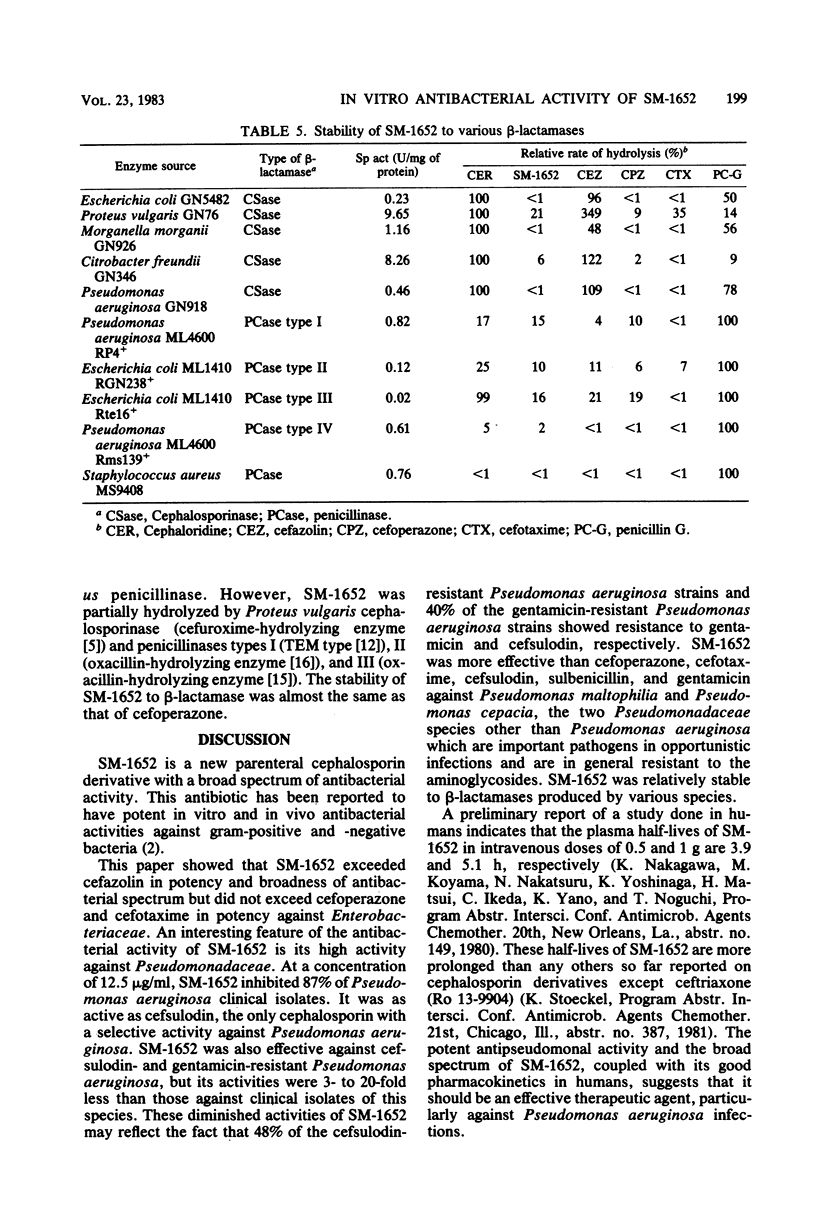Abstract
SM-1652 (sodium 7-[D(-)-alpha-(4-hydroxy-6-methylpyridine-3-carboxamido)-alpha-(4-hydroxyphenyl)acetamido]-3-[(1-methyl-1H-tetrazol-5-yl) thiomethyl]-3-cephem-4-carboxylate) is a new semisynthetic cephalosporin derivative with a broad spectrum of antibacterial activity. Its in vitro activity against gram-positive bacteria was comparable to that of cefazolin. SM-1652 exceeded cefazolin in potency and broadness of antibacterial activity against such Enterobacteriaceae as indole-positive Proteus spp., Enterobacter cloacae, and Serratia marcescens. A remarkable feature of the spectrum of SM-1652 is its high activity against Pseudomonadaceae. Against 200 clinical isolates of Pseudomonas aeruginosa, SM-1652 was significantly more active than cefoperazone, cefotaxime, and sulbenicillin and as active as cefsulodin. The activities of SM-1652 against Pseudomonas maltophilia and Pseudomonas cepacia were superior to those of cefoperazone, cefotaxime, cefsulodin, sulbenicillin, and gentamicin. SM-1652 was relatively stable to hydrolysis with plasmid-mediated penicillinases and cephalosporinases produced by gram-negative bacteria.
Full text
PDF





Selected References
These references are in PubMed. This may not be the complete list of references from this article.
- Heymès R., Lutz A., Schrinner E. Experimental evaluation of HR756, a new cephalosporin derivative: pre-clinical study. Infection. 1977;5(4):259–260. doi: 10.1007/BF01640793. [DOI] [PubMed] [Google Scholar]
- LOWRY O. H., ROSEBROUGH N. J., FARR A. L., RANDALL R. J. Protein measurement with the Folin phenol reagent. J Biol Chem. 1951 Nov;193(1):265–275. [PubMed] [Google Scholar]
- Matsubara N., Minami S., Muraoka T., Saikawa I., Mitsuhashi S. In vitro antibacterial activity of cefoperazone (T-1551), a new semisynthetic cephalosporin. Antimicrob Agents Chemother. 1979 Dec;16(6):731–735. doi: 10.1128/aac.16.6.731. [DOI] [PMC free article] [PubMed] [Google Scholar]
- Motley M., Shadomy S. In vitro studies with cefazolin. Antimicrob Agents Chemother. 1974 Dec;6(6):856–861. doi: 10.1128/aac.6.6.856. [DOI] [PMC free article] [PubMed] [Google Scholar]
- Newsom S. W., Sykes R. B., Richmond M. H. Detection of a beta-lactamase markedly active against carbenicillin in a strain of Pseudomonas aeruginosa. J Bacteriol. 1970 Mar;101(3):1079–1080. doi: 10.1128/jb.101.3.1079-1080.1970. [DOI] [PMC free article] [PubMed] [Google Scholar]
- Ross G. W., Chanter K. V., Harris A. M., Kirby S. M., Marshall M. J., O'Callaghan C. H. Comparison of assay techniques for beta-lactamase activity. Anal Biochem. 1973 Jul;54(1):9–16. doi: 10.1016/0003-2697(73)90241-8. [DOI] [PubMed] [Google Scholar]
- Sawada Y., Yaginuma S., Tai M., Iyobe S., Mitsuhashi S. Plasmid-mediated penicillin beta-lactamases in Pseudomonas aeruginosa. Antimicrob Agents Chemother. 1976 Jan;9(1):55–60. doi: 10.1128/aac.9.1.55. [DOI] [PMC free article] [PubMed] [Google Scholar]
- Tsuchiya K., Kondo M., Nagatomo H. SCE-129, antipseudomonal cephalosporin: in vitro and in vivo antibacterial activities. Antimicrob Agents Chemother. 1978 Feb;13(2):137–145. doi: 10.1128/aac.13.2.137. [DOI] [PMC free article] [PubMed] [Google Scholar]


